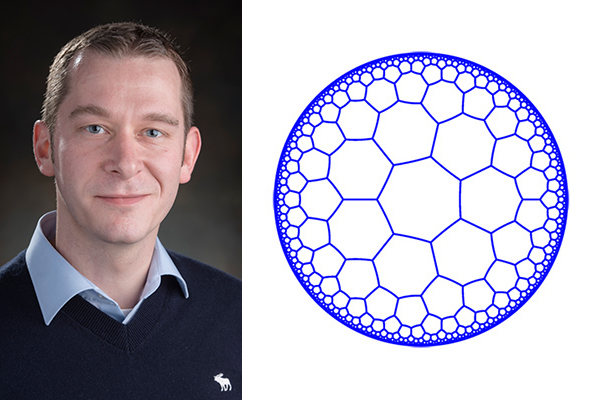Building on fundamental physics knowledge
Suzette Chan - 12 April 2021

Igor Boettcher says that it is impossible to tile your bathroom with regular 7-gons, but it is possible in curved hyperbolic space. Recent cutting-edge experiments realize tilings (see image on the left) to understand the behavior of quantum particles in curved space.
In February, the Department of Physics welcomed a new faculty member, Igor Boettcher. Boettcher is an assistant professor of theoretical condensed matter physics, but his work will allow him to collaborate with scientists across many fields of physics and mathematics research.
How did you become interested in studying physics?
My curiosity about physics was sparked when, as a teenager, I would devour popular science books on the elementary particles that comprise all matter or the origin of the cosmos. It still astonishes me to this day that we managed and continues to discover these fundamental principles of our world through a series of ever more intricate experiments and measurements. In addition, studying physics struck me as particularly attractive, because the courses cover a very broad range of topics without the need to specialize too early and physics students acquire analytical and technical skill sets that are important for a large variety of jobs.
What’s the focus of your research program?
I try to understand how ensembles of many particles show novel collective behavior that cannot be seen with only a few particles. We have all experienced that, for instance, a crowd of people can act very differently than an individual, and the same is true for the particles of physics. This phenomenon often has striking technological applications: just think of the many different devices that can be built from metals and insulators, which are two very different kinds of solids, although both are simply made from atoms.
Modern many particle physics experiments use a large variety of particles such as atoms, electrons, ions, or light. As a theoretical condensed matter physicist, I develop the mathematical and conceptual framework required to understand the often surprising findings and propose new experiments to push further into the unknown.
One very fascinating recent set of experiments that I am involved in realizes a space of negative curvature with resonators or electric circuits, and studies the behavior of a few and eventually many particles in such a curved space. This can help us, for instance, to understand what may happen close to a black hole, a place that itself is clearly rather inaccessible to experiments.
Are there opportunities to work with other physics researchers in your areas of interest?
My field of research naturally involves many collaborations with theoretical and experimental physicists from various areas, such as atomic or nuclear physics, quantum optics or quantum information, or mathematical and high-energy particle physics. I highly value this exchange across disciplines as it often inspires new and original ways to attack physics problems.
What are the biggest questions in your field that you are answering or would like to help answer?
Experiments on quantum many particle systems have reached an impressive accuracy and breadth over the last decades. As a theorist, I would like to see our mathematical toolbox used to describe the observed phenomena to evolve at a similar pace. In particular, with the novel experiments on curved space I mentioned earlier, we face a huge opportunity to expand our theoretical repertoire with new techniques from diverse mathematical disciplines such as topology, geometry, or number theory. This will see a rise in collaborations between physicists and mathematicians, and eventually open new frontiers in physics.